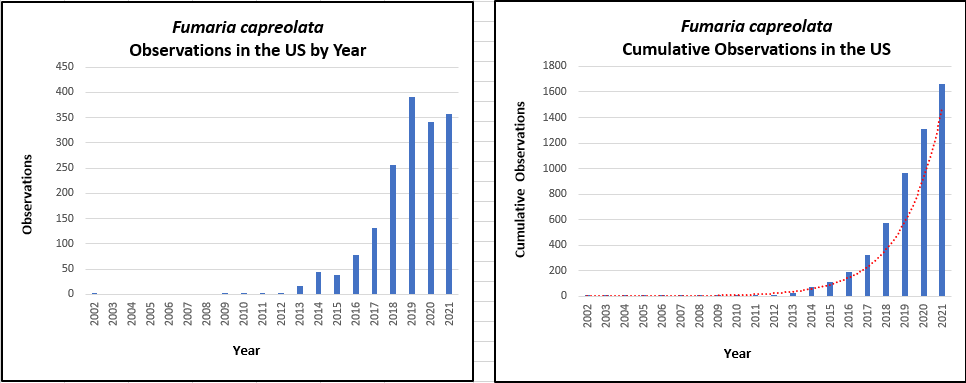How to identify Fumaria capreolata (White Ramping-Fumitory)
Fumaria is usually considered a difficult genus to identify, mainly due to the small size of the features that are useful for identification and the fact that both flowers and fruits are needed for an accurate ID.
Photo tips:
https://www.inaturalist.org/journal/blue_celery/31675-fumaria-what-to-photograph-for-the-identification
This reference describes the photographic evidence and measurements required for accurate identification of fumitories. Close-up pictures of the inflorescence, corollas, sepals, and fruits are required for identification to species.- It’s also important to take a photo of the entire plant.
- Note that fumitories cannot be identified to species without flowers and fruit.
- If there are multiple plants in the picture, it’s helpful to crop your photo to focus on the plant of interest.
How to Identify Fumaria capreolata:
- Height: Stems grow up to 1 meter long and sometimes climb.
- Leaves: Leaves are pinnatisect (lobes with incisions that extend almost, or up to the midrib).
- Inflorescence: There can be up to 20 flowers per inflorescence, which is 2-3.5 cm in length (excluding peduncle).
- Corolla is 9-14 mm in length. Outer petals are white/cream with red/purple tips. They gradually become pink after pollination and may have a red stripe along the top of the flower.
- Pedicels are rigidly recurved in fruit (downward curving stalks). Bracteoles are equal to or shorter than pedicels.
- Fruit: The fruits are compressed laterally, +- keeled.
- Habitat: Temperate climate. Disturbed places. Fumaria capreolata can become naturalized in areas of natural vegetation and smother low-growing plants, becoming an environmental weed.
Similar Species:
- Fumaria muralis (Common Ramping-Fumitory )
- Fumaria parviflora (Fineleaf Fumitory )
- Fumaria bastardii (Tall Ramping-Fumitory)
How to differentiate F. capreolata from F. muralis:
- F. capreolata has larger cream-colored flowers with a red-black tip; F. muralis has pink flowers with a dark red or purple tip.
- The inflorescence of F. capreolata is at least as long as the stalk and the lower flowers are recumbent (turn downward).
- F. capreolata’s mature flowers develop a red stripe during fructification.
- F. capreolata may hybridize with F. muralis.
How to differentiate F. capreolata from F. parviflora
- F. parviflora has much finer leaf-segments than F. capreolata and the flowers are held differently on the stems. The downward pointing flowers are very typical of F. capreolata.
References:
- Calflora: https://www.calflora.org/cgi-bin/species_query.cgi?where-calrecnum=8662
- Jepson eFlora: https://ucjeps.berkeley.edu/eflora/eflora_display.php?tid=26193
- Flora of North America: http://www.efloras.org/florataxon.aspx?flora_id=1&taxon_id=233500652
- Comparison of Fumitory Species: https://naturebftb.co.uk/wp-content/uploads/2021/04/Fumitories-and-Ramping-fumitories-crib.pdf
iNaturalist:
o Taxa Info: https://www.inaturalist.org/taxa/57852-Fumaria-capreolata
o Project: https://www.inaturalist.org/projects/fumaria-capreolata-in-the-usa
o Parent Project: https://www.inaturalist.org/projects/fumaria-species-in-the-usa
o Identification Info: https://www.inaturalist.org/journal/blue_celery/14150-fumitories-of-north-america






